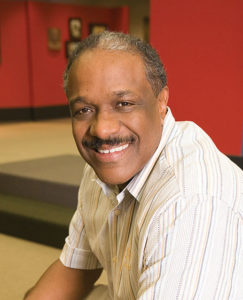
Featured reader Christopher Paul Curtis will be will be reading alongside Sarah Carson at 6 PM, Saturday July 22nd at the Flint Public Library. From Mr. Curtis’ website:
The second oldest of five siblings, Christopher was born and raised in Flint, Michigan which has been used as a prominent setting in several stories including The Watsons Go to Birmingham – 1963 and Bucking the Sarge. Graduating from Flint Southwestern High School, Christopher immediately did two things: 1) enrolled at Flint’s University of Michigan and 2) applied for a job at Fisher Body Plant No. 1, a General Motors assembly facility. This was extremely typical for many young adults. Most blue-collar jobs, particularly in “the jungle” where Christopher worked, were often heavy-duty, hard-working tasks, requiring minimal educational skills at best. The pay and benefits couldn’t be beat, so for high school graduates that wanted a significant income right out of school, General Motors was the ticket.
Of all the various departments one could work, the “Jungle” was easily one of the worst. The Jungle was where the manufacturing process began, various sizes and shapes of metal being welded together at sequential work stations that eventually became the body frame of the automobile. With all the large welding equipment hanging from the ceiling like Amazon liana branches, as well as pneumatic, electrical and other connections running to and from all the robotic welding arms gave the area the appearance of a mechanical jungle. In addition, the scent of oil, grease and lingering smoke from the welding guns only added to the metallic ambiance.
Once the car’s basic skeletal frame was established, one of the first things to get added were the doors. This was Christopher’s work station. During the 70s, Fisher Body produced three models – the Electra 225 (also known as a “deuce and a quarter”), LaSabre and Riveria. All very big and extremely heavy vehicles. Very little plastic was used; the cars were made of mostly metal. Because the doors were so big and quite heavy, the company set the job up for two men to alternate installing the doors on every other car coming down the assembly line. This went on each night for eight or more hours, about 60 cars per hour.
Christopher and his coworker decided that instead of working every other car, they would work every 30 minutes. This allowed Christopher time to do other things — besides reading novels (one of his great passions), he began writing to overcome the boredom. Some of the writings were letters; others were sketches of stories that, like his character Bud Caldwell (Bud, Not Buddy), began the colorful sojourn which led him to become one of America’s leading authors of children’s literature.
Christopher currently lives in Detroit, Michigan and in his free time still enjoys reading, playing basketball and collecting music.
As the Flint Literary Festival approaches, we hope you’ll take a few minutes to read this interview with Mr. Curtis, posted by the Center for the Collaborative Classroom.